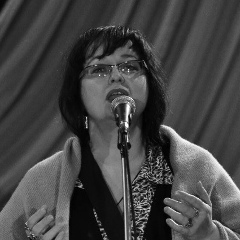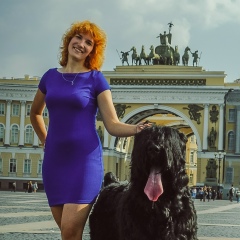NEUZEIT-GROTESK, 1932
(«предок» популярного и простого DIN)
Всего через три года после выпуска не слишком успешного Elegant-Grotesk словолитня Stempel создаёт новый геометрический гротеск — Neuzeit-Grotesk. Этот шрифт в четырёх начертаниях (светлом, нормальном, полужирном и жирном) спроектировал в 1928–1930 годах художник шрифта Вильгельм Пишнер (Wilhelm Pischner, 1904–1989), а затем шрифт был отлит для ручного и линотипного набора. Подобно говорящему имени Futura, название Neuzeit переводится как «современность», и гарнитура также претендовала на место главного шрифта своего времени. Однако геометрическая основа Neuzeit никак не подчёркивалась в его описаниях, акцент в рекламных материалах был сделан на ключевом отличии шрифта от современников — высоком росте строчных знаков. При наборе таким шрифтом за счёт коротких выносных элементов межстрочное расстояние в тексте получалось меньше, что давало возможность верстать текст гораздо компактнее.
Большинство знаков этого шрифта достаточно широкие, что позволяет добиться равномерности набора, при этом в светлом и полужирном начертаниях формы знаков немного заужены. Как и в Berthold-Grotesk, в Neuzeit-Grotesk точки умлаута сближаются с прописной О, но тонкая обводка вокруг позволяет им не касаться друг друга. Исходный дизайн включает в себя альтернативы некоторых строчных: двухчастную букву а и привычную букву u с правым основным штрихом (в основном наборе u имеет лаконичную форму подковы).
В последующие годы система начертаний Neuzeit-Grotesk постепенно расширялась. В конце 1930-х было добавлено два узких начертания (полужирное и жирное), основанных на рисунках Пишнера. Однако только 15 лет спустя в шрифте появились курсивные начертания: светлое, нормальное и жирное. В 1959 году специалистами Stempel было создано книжное начертание Neuzeit-Buchschrift. Оно немного светлее нормального начертания Neuzeit-Grotesk и дополнено парным более плотным начертанием Kräftige Neuzeit-Buchschrift (буквально — «крепкий», обычно такие начертания являются чем-то средним между нормальным и полужирным начертаниями).
В англоговорящих странах Neuzeit-Grotesk был известен как Stempel Gothic. Каталог образцов шрифта фирмы Stempel, выпущенный в Лондоне фирмой Caslon Machinery Ltd. (в то время эксклюзивный дистрибьютер Stempel в Англии), ссылается на это имя и отмечает, что оно было изменено на Stempel Sans. Такое переименование неудивительно, поскольку во вступительном слове большинства каталогов Neuzeit термин sans sérif во многом противопоставлялся термину grotesk (или, возможно, gothic).
В 1966 году фирмы Stempel и Linotype, вдохновившись дизайном Neuzeit-Buchschrift, разработали новую текстовую гарнитуру — Neuzeit S, которая была выпущена как эксклюзивный шрифт для нового корпоративного дизайна фирмы Siemens. Neuzeit S далеко ушёл от своего прародителя Neuzeit-Grotesk: многие знаки практически полностью потеряли геометрическое начало, изменились их конструкции и пропорции, и, по сути, Neuzeit S имеет очень мало общего с тем Neuzeit-Grotesk, который мы знаем.
Об оригинальном Neuzeit-Grotesk не вспоминали, пока в 1970 году его не решил воскресить Немецкий институт стандартизации (DIN: Deutsches Institut für Normung). Нормальное и полужирное узкое начертания были перерисованы для акцидентного использования и получили название DIN 30640. Все знаки были чуть расширены, нижние выносные элементы увеличены, а альтернативные а и u стали знаками основного набора. Замена форм знаков порой может сильно изменить восприятие гарнитуры, но Neuzeit-Grotesk удалось сохранить свой оригинальный образ.
Из статьи typejournal.ru/articles/A-Brief-History-of-Geometric-Sans
(«предок» популярного и простого DIN)
Всего через три года после выпуска не слишком успешного Elegant-Grotesk словолитня Stempel создаёт новый геометрический гротеск — Neuzeit-Grotesk. Этот шрифт в четырёх начертаниях (светлом, нормальном, полужирном и жирном) спроектировал в 1928–1930 годах художник шрифта Вильгельм Пишнер (Wilhelm Pischner, 1904–1989), а затем шрифт был отлит для ручного и линотипного набора. Подобно говорящему имени Futura, название Neuzeit переводится как «современность», и гарнитура также претендовала на место главного шрифта своего времени. Однако геометрическая основа Neuzeit никак не подчёркивалась в его описаниях, акцент в рекламных материалах был сделан на ключевом отличии шрифта от современников — высоком росте строчных знаков. При наборе таким шрифтом за счёт коротких выносных элементов межстрочное расстояние в тексте получалось меньше, что давало возможность верстать текст гораздо компактнее.
Большинство знаков этого шрифта достаточно широкие, что позволяет добиться равномерности набора, при этом в светлом и полужирном начертаниях формы знаков немного заужены. Как и в Berthold-Grotesk, в Neuzeit-Grotesk точки умлаута сближаются с прописной О, но тонкая обводка вокруг позволяет им не касаться друг друга. Исходный дизайн включает в себя альтернативы некоторых строчных: двухчастную букву а и привычную букву u с правым основным штрихом (в основном наборе u имеет лаконичную форму подковы).
В последующие годы система начертаний Neuzeit-Grotesk постепенно расширялась. В конце 1930-х было добавлено два узких начертания (полужирное и жирное), основанных на рисунках Пишнера. Однако только 15 лет спустя в шрифте появились курсивные начертания: светлое, нормальное и жирное. В 1959 году специалистами Stempel было создано книжное начертание Neuzeit-Buchschrift. Оно немного светлее нормального начертания Neuzeit-Grotesk и дополнено парным более плотным начертанием Kräftige Neuzeit-Buchschrift (буквально — «крепкий», обычно такие начертания являются чем-то средним между нормальным и полужирным начертаниями).
В англоговорящих странах Neuzeit-Grotesk был известен как Stempel Gothic. Каталог образцов шрифта фирмы Stempel, выпущенный в Лондоне фирмой Caslon Machinery Ltd. (в то время эксклюзивный дистрибьютер Stempel в Англии), ссылается на это имя и отмечает, что оно было изменено на Stempel Sans. Такое переименование неудивительно, поскольку во вступительном слове большинства каталогов Neuzeit термин sans sérif во многом противопоставлялся термину grotesk (или, возможно, gothic).
В 1966 году фирмы Stempel и Linotype, вдохновившись дизайном Neuzeit-Buchschrift, разработали новую текстовую гарнитуру — Neuzeit S, которая была выпущена как эксклюзивный шрифт для нового корпоративного дизайна фирмы Siemens. Neuzeit S далеко ушёл от своего прародителя Neuzeit-Grotesk: многие знаки практически полностью потеряли геометрическое начало, изменились их конструкции и пропорции, и, по сути, Neuzeit S имеет очень мало общего с тем Neuzeit-Grotesk, который мы знаем.
Об оригинальном Neuzeit-Grotesk не вспоминали, пока в 1970 году его не решил воскресить Немецкий институт стандартизации (DIN: Deutsches Institut für Normung). Нормальное и полужирное узкое начертания были перерисованы для акцидентного использования и получили название DIN 30640. Все знаки были чуть расширены, нижние выносные элементы увеличены, а альтернативные а и u стали знаками основного набора. Замена форм знаков порой может сильно изменить восприятие гарнитуры, но Neuzeit-Grotesk удалось сохранить свой оригинальный образ.
Из статьи typejournal.ru/articles/A-Brief-History-of-Geometric-Sans
NEUZEIT-GROTESK, 1932
(The "ancestor" of the popular and simple DIN)
Just three years after the launch of the not very successful Elegant-Grotesk type foundry, Stempel creates a new geometric sans-serif - Neuzeit-Grotesk. This typeface in four weights (light, normal, bold and bold) was designed in 1928–1930 by the type artist Wilhelm Pischner (1904–1989), and then the typeface was cast for hand and linotype typing. Like the talking name Futura, the name Neuzeit translates to “modernity,” and the typeface also claimed the place of the main typeface of its time. However, the geometric basis of Neuzeit was not emphasized in any way in his descriptions, the emphasis in advertising materials was placed on the key difference between the font and its contemporaries - the high growth of lowercase characters. When typing in such a font, due to short descenders, the line spacing in the text turned out to be less, which made it possible to typeset the text much more compactly.
Most of the characters in this font are wide enough to achieve uniform typing, while in light and bold styles, the shapes of the characters are slightly narrowed. As in Berthold-Grotesk, in Neuzeit-Grotesk the umlaut points converge to the uppercase O, but the thin border around them keeps them away from each other. The original design includes alternatives to some lowercase letters: the two-part letter a and the familiar letter u with a right main stroke (in the main set, u has a laconic horseshoe shape).
In the following years, the Neuzeit-Grotesk typeface system gradually expanded. In the late 1930s, two narrow styles (bold and bold) were added based on Pischner's drawings. However, only 15 years later, italics appeared in type: light, normal and bold. In 1959, Stempel specialists created the Neuzeit-Buchschrift typeface. It is slightly lighter than the normal Neuzeit-Grotesk style and is complemented by a pair of denser Kräftige Neuzeit-Buchschrift (literally "strong", usually these weights are somewhere in between normal and bold).
In English speaking countries, Neuzeit-Grotesk was known as Stempel Gothic. Stempel typeface sample catalog published in London by Caslon Machinery Ltd. (at the time the exclusive distributor of Stempel in England), refers to this name and notes that it was changed to Stempel Sans. This renaming is not surprising, since in the introductory remarks of most Neuzeit catalogs, the term sans sérif was in many ways opposed to the term grotesk (or perhaps gothic).
In 1966, Stempel and Linotype, inspired by the design of Neuzeit-Buchschrift, developed a new typeface, Neuzeit S, which was released as an exclusive font for the new corporate design of Siemens. Neuzeit S has gone far from its progenitor Neuzeit-Grotesk: many signs have almost completely lost their geometric origin, their designs and proportions have changed, and, in fact, Neuzeit S has very little in common with the Neuzeit-Grotesk that we know.
The original Neuzeit-Grotesk was not remembered until 1970, when the German Institute for Standardization (DIN: Deutsches Institut für Normung) decided to revive it. The normal and bold narrow weights were redrawn for display use and named DIN 30640. All characters were slightly widened, descenders were enlarged, and the alternative a and u became characters in the main set. Replacing the shapes of characters can sometimes dramatically change the perception of a typeface, but Neuzeit-Grotesk has managed to maintain its original image.
From article typejournal.ru/articles/A-Brief-History-of-Geometric-Sans
(The "ancestor" of the popular and simple DIN)
Just three years after the launch of the not very successful Elegant-Grotesk type foundry, Stempel creates a new geometric sans-serif - Neuzeit-Grotesk. This typeface in four weights (light, normal, bold and bold) was designed in 1928–1930 by the type artist Wilhelm Pischner (1904–1989), and then the typeface was cast for hand and linotype typing. Like the talking name Futura, the name Neuzeit translates to “modernity,” and the typeface also claimed the place of the main typeface of its time. However, the geometric basis of Neuzeit was not emphasized in any way in his descriptions, the emphasis in advertising materials was placed on the key difference between the font and its contemporaries - the high growth of lowercase characters. When typing in such a font, due to short descenders, the line spacing in the text turned out to be less, which made it possible to typeset the text much more compactly.
Most of the characters in this font are wide enough to achieve uniform typing, while in light and bold styles, the shapes of the characters are slightly narrowed. As in Berthold-Grotesk, in Neuzeit-Grotesk the umlaut points converge to the uppercase O, but the thin border around them keeps them away from each other. The original design includes alternatives to some lowercase letters: the two-part letter a and the familiar letter u with a right main stroke (in the main set, u has a laconic horseshoe shape).
In the following years, the Neuzeit-Grotesk typeface system gradually expanded. In the late 1930s, two narrow styles (bold and bold) were added based on Pischner's drawings. However, only 15 years later, italics appeared in type: light, normal and bold. In 1959, Stempel specialists created the Neuzeit-Buchschrift typeface. It is slightly lighter than the normal Neuzeit-Grotesk style and is complemented by a pair of denser Kräftige Neuzeit-Buchschrift (literally "strong", usually these weights are somewhere in between normal and bold).
In English speaking countries, Neuzeit-Grotesk was known as Stempel Gothic. Stempel typeface sample catalog published in London by Caslon Machinery Ltd. (at the time the exclusive distributor of Stempel in England), refers to this name and notes that it was changed to Stempel Sans. This renaming is not surprising, since in the introductory remarks of most Neuzeit catalogs, the term sans sérif was in many ways opposed to the term grotesk (or perhaps gothic).
In 1966, Stempel and Linotype, inspired by the design of Neuzeit-Buchschrift, developed a new typeface, Neuzeit S, which was released as an exclusive font for the new corporate design of Siemens. Neuzeit S has gone far from its progenitor Neuzeit-Grotesk: many signs have almost completely lost their geometric origin, their designs and proportions have changed, and, in fact, Neuzeit S has very little in common with the Neuzeit-Grotesk that we know.
The original Neuzeit-Grotesk was not remembered until 1970, when the German Institute for Standardization (DIN: Deutsches Institut für Normung) decided to revive it. The normal and bold narrow weights were redrawn for display use and named DIN 30640. All characters were slightly widened, descenders were enlarged, and the alternative a and u became characters in the main set. Replacing the shapes of characters can sometimes dramatically change the perception of a typeface, but Neuzeit-Grotesk has managed to maintain its original image.
From article typejournal.ru/articles/A-Brief-History-of-Geometric-Sans

У записи 3 лайков,
1 репостов,
690 просмотров.
1 репостов,
690 просмотров.
Эту запись оставил(а) на своей стене Максим Вигилев
























